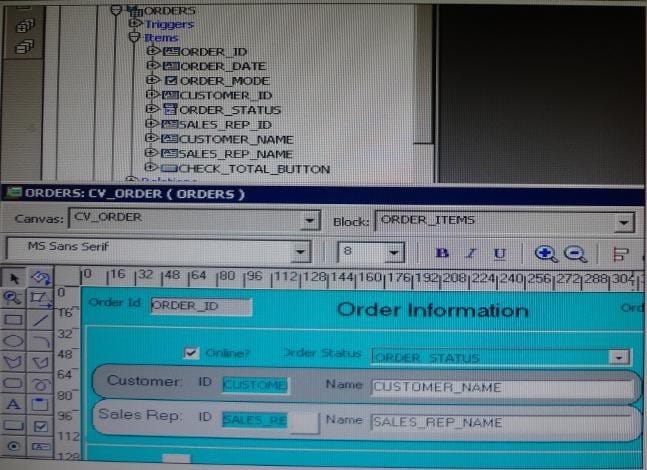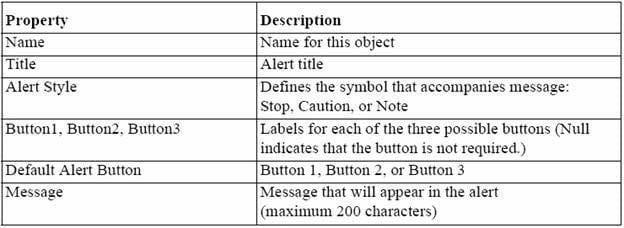Exam Details
Exam Code
:1Z0-151Exam Name
:Oracle Fusion Middleware 11g: Build Applications with Oracle FormsCertification
:Oracle CertificationsVendor
:OracleTotal Questions
:90 Q&AsLast Updated
:
Oracle Oracle Certifications 1Z0-151 Questions & Answers
-
Question 71:
View the Exhibit.

You have placed the following code in a Post insert trigger on the Orders block:
SELECT orders_seq.NEXTVAL INTO :orders.order_id FORM SYS.dual;
You have also set Item properties for the Order_Id Item in the form so that users cannot directly enter an Order ID.
As the SUMMIT user, you run the form to test it. Yon are able to insert a record in the block, but when you click Save, you have a database error as shown in the Exhibit.
What is the probable cause of this error?
A. The code should be in Pre_insert trigger instead
B. The code should be in a database trigger instead
C. You should change the code to select the sequence number from SUMMIT.dual instead.
D. You should create the sequence in the database, because the runtime error is an indication that is does not exist.
E. You should assign a temporary value to the Order_Id item before saving the form.
-
Question 72:
You have installed WebLogic and Forms with a default configuration, which has been tested and determined to be correct.
After creating a basic form in the Forms Builder, you click Run Form to test it. Forms Builder displays an error dialog box with the following message:
FRM-10142: The HTTP Listener is not running on
at port 9001. Please start the listener or check your runtime preferences. What is one action that you can take to resolve this error?
A. Start the Web Logic Administration server.
B. Start the WLS_FORMS managed server.
C. Change the serverURL parameter in formsweb.cfg
D. Start the Oracle HTTP server.
E. Start WebCache.
-
Question 73:
Which statement is always true about using OPEN_FORM to open multiple forms in an application?
A. Database transactions are always continued across forms.
B. Code is always shared among forms.
C. A calling form must pass data to a called form.
D. A global record group is always created.
E. Only A and B are true.
F. Only B and C are true.
G. Only C and D are true.
H. None of the statements above are true.
-
Question 74:
You are planning the alerts that are needed for your Human Resources application. You wish to display the following in alerts:
*
A message to inform the user about being at the just record
*
A warning about a potential conflict with the data just entered
*
A message to display a validation error to the user
*
A warning that the salary is out of range and that asks whether the user wants to correct it
You want the note symbol ( ) to appear on alerts that display only informative messages, the

warning symbol to appear on messages where you will allow the user to continue despite some data problem, and the alarm boll symbol to appear where the user will not be allowed to continue without correcting the situation that caused the alert to be displayed.
You want to define the minimum number of alerts possible and customize them at run time.
Which alerts should you define?
A. One Note style alert and caution style alert
B. One Note style alert and one Stop style alert
C. On Caution style alert and one stop style alert
D. On Note style alert, one Caution style alert, and one Stop style alert
E. Two Caution style alerts and one Stop style alert
-
Question 75:
You have created an editor named MyEditor, and you want it to be available to edit the text item Product_Description. You can associate the editor with the text item by setting the Editor property of Product_Description to MyEditor.
A. True
B. False
-
Question 76:
The Orders form is sometimes run automatically and sometimes run from the Customers form, when it is
run from the Customers form, any queries should be restricted to the customer that is currently selected.
The Customers form button that runs the Orders form sets a global variable to the current customer ID.
The Orders form has a button labeled Execute Query with the following When-Button Pressed trigger:
DEFAULT_VALUE (NULL, 'GLOBAL.Customer_id');
IF: GLOBAL.customer_id IS NOT NULL
THEN
SET_BLOCK_PROPERTY ('orders', DEFAULT_WHERE, 'orders.customer_id = ' | |
:GLOBAL.CUSTOMER_id);
END IF;
EXECUTE_QUERY
You want to duplicate that functionality in a menu item for the Summit menu that is attached To the Orders
form.
What changes must you make to the code so that the menu code functions as it does in the form?
A. Change both occurrence of :GLOBAL.customer_id to 'GLOBAL.customer_id'.
B. Change 'GLOBAL.customer_id' in line 1 to :GLOBAL.customer_id.
C. Change both occurrence of :GLOBAL.customer_id to NAME_IN ('GLOBAL.customer_id').
D. You do not need to change anything; the code compiles and functions correctly in the menu item.
E. You cannot add this type of code in the menu because it refers to the items on the form that cannot be referenced from a menu.
-
Question 77:
To avoid overloading the database during busy times, you decide to restrict the queries that are executed on the Orders form so that users query by either Order ID or Customer ID during these times. Which trigger is most appropriate for the code to enforce this restriction?
A. When-New-Form-instance
B. When-New-Block-instance
C. On-Query
D. Pre-Query E. Post-Query
-
Question 78:
View the Exhibit.

The Departments table in the database contains four columns. In a new form, you use the Data Block Wizard to add all columns to the block, but in the layout Wizard, you choose all columns except Location_Id to add to the canvas. The Object Navigator and layout Editor appear as shown in the Exhibit.
You then decide that you do need to display Location_Id on the canvas. What object must you select before invoking the Layout Editor in re-entrant mode to make this change?
A. the text item tool in the Layout Editor
B. Frame 16 in either the Object Navigator or the layout Editor
C. Canvas4 in either the Object Navigator or the Layout Editor
D. Location_Id in the Object Navigator
E. the Departments data block in the Object Navigator
-
Question 79:
You have created a complex menu structure with several types of menu objects. To which objects would you assign menu commands?
A. main menus
B. individual menus
C. submenus
D. menu items
E. all of the above
-
Question 80:
In Forms Builder, the iconic buttons on the form are blank, but when you click Run Form the form appears in the browser with Images in the iconic buttons.
What are two things that you can check to track the source of this problem?
A. forms Builder runtime preferences
B. the UI_ICON setting in the operating system
C. the iconpath setting in the Forms registry file
D. the UI_ICOM_EXTENSION setting in the operating system
E. the iconextension setting in the Forms registry file
F. the FORMS_PATH setting in the Forms environment file
G. the classpath setting in the operating system
Related Exams:
1Z0-020
Oracle8i: New Features for Administrators1Z0-023
Architecture and Administration1Z0-024
Performance Tuning1Z0-025
Backup and Recovery1Z0-026
Network Administration1Z0-034
Upgrade Oracle9i/10g OCA to Oracle Database OCP1Z0-036
Managing Oracle9i on Linux1Z0-041
Oracle Database 10g: DBA Assessment1Z0-052
Oracle Database 11g: Administration Workshop I1Z0-053
Oracle Database 11g: Administration II
Tips on How to Prepare for the Exams
Nowadays, the certification exams become more and more important and required by more and more enterprises when applying for a job. But how to prepare for the exam effectively? How to prepare for the exam in a short time with less efforts? How to get a ideal result and how to find the most reliable resources? Here on Vcedump.com, you will find all the answers. Vcedump.com provide not only Oracle exam questions, answers and explanations but also complete assistance on your exam preparation and certification application. If you are confused on your 1Z0-151 exam preparations and Oracle certification application, do not hesitate to visit our Vcedump.com to find your solutions here.
